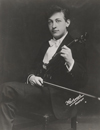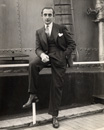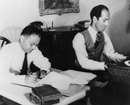Reviews
The Power of Paul Sacher
NEW YORK -- The name of Paul Sacher probably looms larger than that of any other individual in the annals of music patronage in the 20th century. His commissioning of some 146 works between 1926 and 1999, including scores by Bartok, Stravinsky, Hindemith, Honegger, Carter, and Boulez, tends, at least in the United States, to overshadow his own activities as a conductor and as founder of the Basle Chamber Orchestra, which was his vehicle for introducing new works and exploring (to a lesser degree) old ones. He established the ensemble in 1926 and disbanded it in 1986; and through the years he remained steadily rooted in his native city of Basle. He married money (lots of it), knew from an early age exactly what he wanted to do, and calculated every move to achieve his ends.
A new biography by Lesley Stephenson, "Symphony of Dreams: The Conductor and Patron Paul Sacher" (Scarecrow Press, Lanham MD, 2003; $29.95) traces his complicated life in fascinating detail. Stephenson, a New Zealander who grew up in Australia and is identified as an opera and concert singer as well as a journalist, worked closely with Sacher for 15 years as ghostwriter and translator. Sacher cooperated with her on the book on the understanding that it would not be published in his lifetime. His death in 1999 freed her to produce this revealing, even-handed account of a life that was extraordinarily focused and more than a little forbidding.
Sacher was born in 1906 of working-class parents; he attended the Basle Conservatory and played the violin, but knew from the start that conducting would be his calling. At 20 he organized his chamber orchestra, and for the first ten years its members contributed their services, as did he, without pay. He was by all accounts an outstanding organizer, and somehow managed to keep the ensemble afloat with a volunteer staff as it built up a following and, eventually, international recognition. Meantime, Sacher made his way steadily up from his humble beginnings into the high circles of Basle society, and at 24 met a couple to whom he was immediately drawn: Emanuel Hoffmann and his wife, Maja. Hoffmann was heir to the pharmaceutical company F. Hoffmann-La Roche, his wife a discriminating collector of paintings.
Sacher quickly became an intimate of the Hoffmann family. Two years later, when Emanuel Hoffmann was killed in an automobile accident, Sacher told Stephenson, "I went to Maja straight away. I knew immediately, ‘That is now my way. That is now my path.'" No fewer than 18 months later he and Maja were married; he was 28, she 38. Two weeks after the wedding he bought a house for his parents, drawing on his newly acquired wealth. When he broke the news of his impending marriage to a current mistress in Rome, she was surprisingly understanding, and wrote him that she disdained the "ugly and mean gossip" making the rounds in Basle. His relationship with her continued after his marriage.
This was only one of the earliest of many of love affairs, two of which Stephenson of necessity describes in some detail. When Sacher was 39 or 40 he entered into a relationship with a younger cousin of his wife's, the Countess Nina von Faber-Castell, who lived near Zurich with her husband and his children by a previous marriage. She bore Sacher two daughters (one in 1952, one in 1961); they were accepted by the Count, who seemed oblivious of their parentage and indeed of the relationship, which lasted in secret for 30 years. It came to an end when, at the age of 67, Sacher fell in love with 31-year-old Irmtraut Schmid, a doctor form northern Germany; this too was kept a secret until Sacher informed Nina of it six years later, at which time she ended their liaison. Irmtraut bore Sacher a son, whom he openly acknowledged; she died when the baby, Paul, was three years old.
Juggling several private lives and deeply engaged in conducting still left Sacher the time and energy for another remarkable achievement, his involvement in the management of Roche pharmaceuticals. Maja's two surviving children by Emanuel Hoffmann (a son had died of leukemia) were heirs to an enormous fortune, and Sacher became a powerful presence on the La Roche board, applying his management skills in ways seldom seen by outsiders; the company was noted for its secrecy, a mode well suited to Sacher's natural inclinations. By clandestine but legal means he maneuvered private stock trades to gain majority voting rights for the family. The company, one of the largest makers of vitamin pills in the world, introduced Valium in 1963, and as Stephenson remarks, "Between 1967 and 1977 Hoffmann-La Roche was unquestionably the top pharmaceutical company in the world." In 1971 a single share cost US $45,000. At about this time, Forbes magazine listed Paul Sacher as the third richest man in the world.
The establishment in Basle of the Paul Sacher Foundation in 1986 created an unparalleled research archive of 20th-century music -- one that lured away such collections as the Stravinsky and Carter manuscripts, coveted by the New York Public Library, which was unable to raise the funds to buy them. In the meantime, Sacher's power in the domain of Swiss musical politics, already formidable, was extended through his appointment to the Swiss arts council; during his 15-year term he virtually dictated the awarding of grants; he was opposed only once, and announced that he would resign if his choices were questioned. They never were again.
Stephenson has written a totally absorbing and lucid biography of a complex man who made up his mind at 17 that he would not show emotion or reveal his motives. He suffered from depression, he believed in horoscopes, he used people and cast them off, he was indifferent to family life. And it is to him that the world owes Bartok's "Music for Strings, Percussion and Celesta"; Boulez's "sur Incises"; Carter's Oboe Concerto; Strauss's "Metamorphosen"; Stravinsky's Concerto in D for String Orchestra. A complete list of commissions is given in the index.
A new biography by Lesley Stephenson, "Symphony of Dreams: The Conductor and Patron Paul Sacher" (Scarecrow Press, Lanham MD, 2003; $29.95) traces his complicated life in fascinating detail. Stephenson, a New Zealander who grew up in Australia and is identified as an opera and concert singer as well as a journalist, worked closely with Sacher for 15 years as ghostwriter and translator. Sacher cooperated with her on the book on the understanding that it would not be published in his lifetime. His death in 1999 freed her to produce this revealing, even-handed account of a life that was extraordinarily focused and more than a little forbidding.
Sacher was born in 1906 of working-class parents; he attended the Basle Conservatory and played the violin, but knew from the start that conducting would be his calling. At 20 he organized his chamber orchestra, and for the first ten years its members contributed their services, as did he, without pay. He was by all accounts an outstanding organizer, and somehow managed to keep the ensemble afloat with a volunteer staff as it built up a following and, eventually, international recognition. Meantime, Sacher made his way steadily up from his humble beginnings into the high circles of Basle society, and at 24 met a couple to whom he was immediately drawn: Emanuel Hoffmann and his wife, Maja. Hoffmann was heir to the pharmaceutical company F. Hoffmann-La Roche, his wife a discriminating collector of paintings.
Sacher quickly became an intimate of the Hoffmann family. Two years later, when Emanuel Hoffmann was killed in an automobile accident, Sacher told Stephenson, "I went to Maja straight away. I knew immediately, ‘That is now my way. That is now my path.'" No fewer than 18 months later he and Maja were married; he was 28, she 38. Two weeks after the wedding he bought a house for his parents, drawing on his newly acquired wealth. When he broke the news of his impending marriage to a current mistress in Rome, she was surprisingly understanding, and wrote him that she disdained the "ugly and mean gossip" making the rounds in Basle. His relationship with her continued after his marriage.
This was only one of the earliest of many of love affairs, two of which Stephenson of necessity describes in some detail. When Sacher was 39 or 40 he entered into a relationship with a younger cousin of his wife's, the Countess Nina von Faber-Castell, who lived near Zurich with her husband and his children by a previous marriage. She bore Sacher two daughters (one in 1952, one in 1961); they were accepted by the Count, who seemed oblivious of their parentage and indeed of the relationship, which lasted in secret for 30 years. It came to an end when, at the age of 67, Sacher fell in love with 31-year-old Irmtraut Schmid, a doctor form northern Germany; this too was kept a secret until Sacher informed Nina of it six years later, at which time she ended their liaison. Irmtraut bore Sacher a son, whom he openly acknowledged; she died when the baby, Paul, was three years old.
Juggling several private lives and deeply engaged in conducting still left Sacher the time and energy for another remarkable achievement, his involvement in the management of Roche pharmaceuticals. Maja's two surviving children by Emanuel Hoffmann (a son had died of leukemia) were heirs to an enormous fortune, and Sacher became a powerful presence on the La Roche board, applying his management skills in ways seldom seen by outsiders; the company was noted for its secrecy, a mode well suited to Sacher's natural inclinations. By clandestine but legal means he maneuvered private stock trades to gain majority voting rights for the family. The company, one of the largest makers of vitamin pills in the world, introduced Valium in 1963, and as Stephenson remarks, "Between 1967 and 1977 Hoffmann-La Roche was unquestionably the top pharmaceutical company in the world." In 1971 a single share cost US $45,000. At about this time, Forbes magazine listed Paul Sacher as the third richest man in the world.
The establishment in Basle of the Paul Sacher Foundation in 1986 created an unparalleled research archive of 20th-century music -- one that lured away such collections as the Stravinsky and Carter manuscripts, coveted by the New York Public Library, which was unable to raise the funds to buy them. In the meantime, Sacher's power in the domain of Swiss musical politics, already formidable, was extended through his appointment to the Swiss arts council; during his 15-year term he virtually dictated the awarding of grants; he was opposed only once, and announced that he would resign if his choices were questioned. They never were again.
Stephenson has written a totally absorbing and lucid biography of a complex man who made up his mind at 17 that he would not show emotion or reveal his motives. He suffered from depression, he believed in horoscopes, he used people and cast them off, he was indifferent to family life. And it is to him that the world owes Bartok's "Music for Strings, Percussion and Celesta"; Boulez's "sur Incises"; Carter's Oboe Concerto; Strauss's "Metamorphosen"; Stravinsky's Concerto in D for String Orchestra. A complete list of commissions is given in the index.





 FEATURED JOBS
FEATURED JOBS

 RENT A PHOTO
RENT A PHOTO


